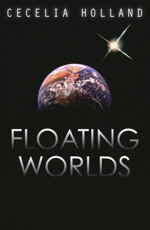Floating Worlds, published in 1975 and the lone science fiction novel by acclaimed historical novelist Cecelia Holland, was unique in being completely devoid of the usual pulp influences present in much space opera up to that time. The elements of true space opera are all there—battles, an advanced, almost magical technology, larger-than-life heroes and villains, a story told on the grand scale—yet the novel as a whole seems to owe almost nothing to earlier science-fictional traditions.
What Floating Worlds does draw on is Holland’s artistry in bringing the past to life in her historical fiction and depicting the people who inhabited that past. Her characters are almost entirely shown through their actions and their reactions to the world around them, not through interior thoughts or monologues. The reader is forced to see the world as they did, directly and without much time for reflection and exposition; their distant, often violent worlds come alive in Holland’s hands.
This stripped-down narrative is a method that, used for science fiction, can have its drawbacks.
Those long, expository passages sometimes derided as “data dumps” can be part of the pleasure of reading science fiction, certain kinds of science fiction anyway. There are writers who would have gone out of their way to explain how the domes of Holland’s ruined Earth and the bubbles of her mutant Styth civilization actually work, or gone into the advanced technology her characters deploy in more detail, and yet Holland’s spare, active narration is truer to her characters, who live in their world without thinking much about the tools they employ, much as most of us do in our own.
The story is straightforward: Paula Mendoza, the protagonist, lives in a commune (with a 1960s ambiance) on an anarchist Earth loosely governed by a Committee. She is chosen to negotiate a treaty with the Styths, mutated humans who inhabit artificial habitats in the atmospheres of Uranus and Saturn, gets involved with Saba, a Styth Akellar (warlord or leader), and goes to live among his people while bearing his child. Among the Styths, whose women are looked down upon and confined, Paula rises to a position of influence but must ultimately confront the collapse of the treaty she has helped to make; war among Earth, the fascistic society of Mars, and the Styths; and the rise of Tanuojin, a Styth of paranormal abilities.
The events of the novel are viewed entirely through Paula, who is one of the strongest and most memorable female characters in science fiction. Floating Worlds, which received a fair amount of attention when it was first published, deserves rediscovery. These days, the conflict between the appealing yet often careless people of an environmentally ravaged Earth and the Styth warrior culture seems even more disquieting and resonant with our own troubled times.
Pamela Sargent’s Seed Seeker, third in a trilogy that includes Earthseed and Farseed, will be published by Tor in 2010. Her other books include the science fiction novels Venus of Dreams and The Shore of Women, the alternative history Climb the Wind, and Ruler of the Sky, a historical novel about Genghis Khan that Gary Jennings called “Formidably researched and exquisitely written.” She lives, works, writes, and reads in Albany, New York.










